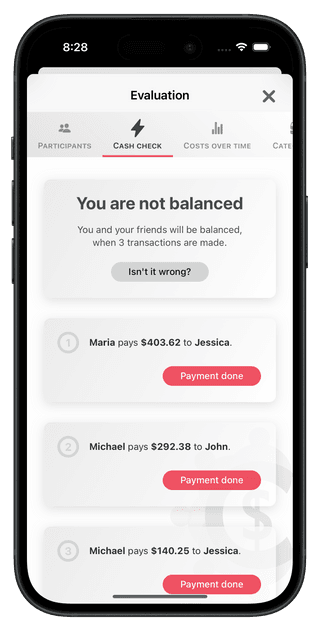
Tracking shared expenses and the intelligently calculated cash settlement are core parts of the Cashinator app.
The app computes fair settlement amounts and optimizes transactions so that as few and as simple payments as possible are required in the end.
Because some users assume the calculation might be wrong, this example explains how Cashinator arrives at its (actually optimal) results.
Learn more about the expense-sharing app. Or try it right away with our online expense calculator.

Steffi, Mareike, and Tom are traveling together. They make three transactions in total:
Transaction 1:
Steffi pays the accommodation (€300). At this point:
1) Mareike owes Steffi €100 and
2) Tom owes Steffi €100.
Transaction 2:
Tom lends Mareike €200 for a skydiving experience. Now:
1) Mareike owes Tom €200,
2) Mareike still owes Steffi €100, and
3) Tom still owes Steffi €100.
Transaction 3:
Steffi buys a €200 train ticket home; her card fails, so Mareike pays.
Summing everything up, the straightforward way to settle would be:
1) Mareike pays Tom €200,
2) Steffi pays Mareike €100,
3) Tom pays Steffi €100.
After these three payments, everyone would be even — which is the intuitive manual solution.
There is a simpler way. Cashinator mathematically optimizes all transactions so that the fewest and simplest payments are required. Instead of three separate payments, Cashinator suggests just one single transaction:
1) Mareike pays Tom €100.
That’s enough to settle everyone. Even though Steffi paid the accommodation, her final balance is zero. Looking at the running balance explains why:
After Transaction 1:
Steffi: +€200, Mareike: −€100, Tom: −€100
After Transaction 2:
Steffi: +€200, Mareike: −€300, Tom: +€100
After Transaction 3:
Steffi: €0, Mareike: −€100, Tom: +€100
After Transaction 3, Steffi is fully settled: nobody owes her money, and she doesn’t owe anyone else— even though she paid for the accommodation. Once Mareike pays Tom €100, the balance for all three participants is perfectly even at €0.
With just this single settlement payment, all debts between the participants are cleared, and no further transactions are needed.
Want more? Explore all features
Cashinator computes a balance per person based on all expenses and then minimizes the number of settlement payments. The goal is to require as few money transfers as possible — without anyone being disadvantaged.
When you set up households or families, Cashinator ensures there is exactly one settlement payment between any two households — regardless of how many people are in each household.
Because the algorithm optimizes. Instead of settling every single debt separately, Cashinator consolidates amounts to avoid unnecessary intermediate transfers. The overall result still matches exactly.
Yes. There are often several mathematically valid ways to settle up. Cashinator chooses a solution that is especially easy to follow — with the fewest payments and clear amounts.
Yes. Cashinator ensures that all balances end at zero. No one pays more or less than their fair share — the optimization only affects the path to that outcome.
Absolutely! Try our online expense calculator. It shows simple examples of how the optimization works. For real trips, shared flats, or projects, use the Cashinator app.
More questions? Check our general FAQ section.